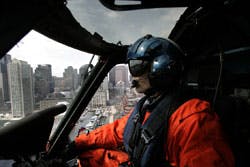Coast Guard to Beef up Surveillance, Firepower Capacities
BOSTON (AP) - To protect the nation's coastline from terrorist attacks, the U.S. Department of Homeland Security is dramatically expanding the Coast Guard's firepower, training and surveillance equipment.
The transformation already has begun in New England.
At Air Station Cape Cod in Bourne, the Coast Guard recently tested its first armed Jayhawk helicopters. The upgraded choppers, armed with M-240 machine guns, armor plating and night-vision equipment, are designed to intimidate, disable and destroy hostile vessels.
Coast Guard Lt. Commander Jay Balda said the helicopters' crew members undergo rigorous training to avoid harming boaters who innocently wander into a secure zone.
"We have to be sure the vessel is hostile before engaging," Balda told The Boston Globe. "The best solution is to not use our armed helicopters except in situations where a Coast Guard surface vessel is there as well, so we can see better if it's a bunch of men with weapons or a couple guys who are ignoring us because they are intoxicated and being stupid."
The Coast Guard has security teams based around the country, including one in Boston. Team members are trained to rappel onto the deck of a moving ship, engage in close-quarters combat and handle weapons of mass destruction.
The Boston-based team helped protect the presidential inauguration, the Super Bowl, the Group of Eight summit in Georgia and the Democratic and Republican national conventions.
"We enforce security zones around high-value assets," said Lieutenant Michael O'Neill, operations officer for the Boston team. "Let's say it's a craft approaching an LNG tanker. We'll intercept it quickly and force them to quickly show their intent."
The Coast Guard recently upgraded its South Boston command center, acquiring new equipment early in preparation for the city's hosting of the 2004 Democratic National Convention.
The military upgrades are part of a comprehensive program detailed by Homeland Security in its 2006 budget plan.
To counter the threat of a terrorist attack, Homeland Security is shifting the Coast Guard from a purely search-and-rescue service to a more militarized force.
"We already know that terrorists operate at sea," said James Carafano, a homeland security specialist at the Heritage Foundation and co-author of a recent study on maritime counterterrorism. "They haven't done it here yet, but someday they will. We don't want to wait to get prepared until the day after a Cole bombing in New York Harbor."
Protecting the nation's shorelines is no small task, with 95,000 miles of coastline, 361 ports, 200 daily arrivals of foreign vessels and 76 million recreational boaters to monitor, according to Coast Guard data.
Since the Sept. 11 attacks, the Coast Guard's annual budget has surged 51 percent, to $7.5 billion in 2005. President Bush has proposed giving it $8.1 billion in 2006.
Despite those budget hikes, the Coast Guard recently told Congress that it has an additional $919 million in priorities that Bush's plan wouldn't fund, including $100 million for maritime security efforts.
